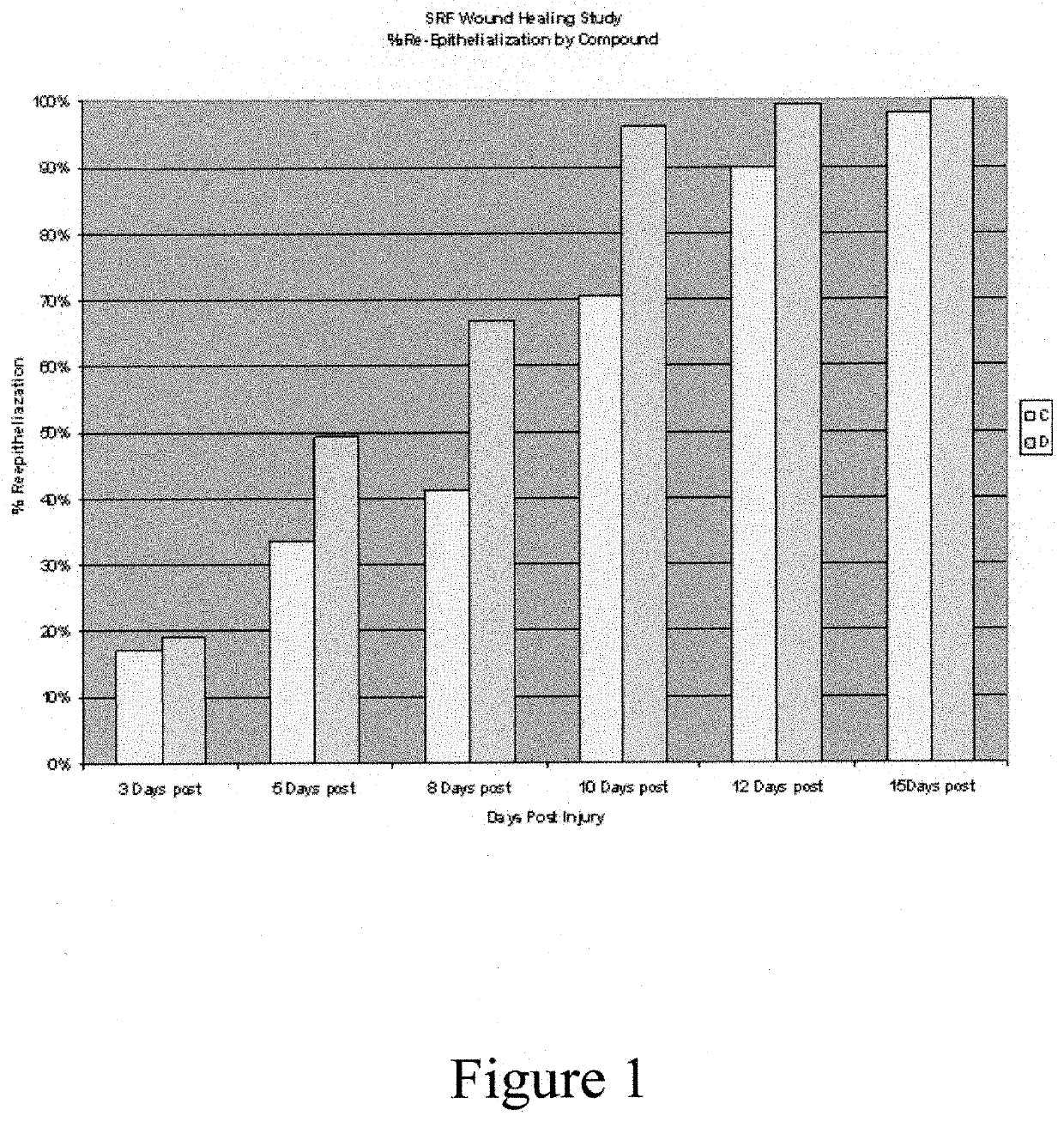Methods and Compositions For Enhancing Synthesis Secretion and Transport of Collagen to Increase Wound Strength
a technology of synthesis secretion and transport, applied in the direction of organic active ingredients, drug compositions, dermatological disorders, etc., can solve the problems of low wound strength, low wound strength, and disruption of normal continuity of structures, so as to improve wound strength, collagen synthesis, and improve wound strength
- Summary
- Abstract
- Description
- Claims
- Application Information
AI Technical Summary
Benefits of technology
Problems solved by technology
Method used
Image
Examples
example 1
Rat Wound Strength Healing Studies
[0066]SRF with and without antioxidants and fatty acids, administered topically, reversed impaired wound healing and increased wound strength by doxorubicin (Doxo) and other cancer or AIDS drugs in rats. Other cancer or HIV drugs tested that have been shown to impair wound healing and decrease wound strength included bleomycin, cisplatin, Urushiol, Imiquimod, Carboplatin, floxuridine, methotrexate, oxaliplatin, Bevacizumab, radiation, and the AIDS drugs including: Nucleoside Reverse Transcriptase Inhibitors (NRTI), Fusion Inhibitors, Highly Active Antiretroviral Therapy (HAART), and Non-Nucleoside Reverse Transcriptase Inhibitors (NNRTI).
[0067]Rats given Doxo (6 mg / kg i.v.) were wounded with linear dermal incisions, and the wound-breaking strength (WBS) was compared among groups of rats differently treated with SRF (calcium pyruvate, magnesium pyruvate, L proline and citrulline) with and without antioxidants and fatty acids. Wound breaking strength ...
example 2
[0070]All previous studies using pyruvate to treat wounds or be used as an antioxidant used only the sodium salt form of pyruvic acid. The drug products that were tested in previous studies used 1-3% sodium pyruvate and other sodium salts of alpha keto acids by weight 1-3% concentrations in the lotions and triple antibiotic formulations. Even though other salts of pyruvic acid like calcium or magnesium etc. have been suggested, no one to date has evaluated the different salts individually or in combination for their ability to enhance cellular repair, mitochondrial repair, enhanced synthesis of adhesion molecules and collagen, to increase wound strength, texture and pigmentation, or to reduce irritation. Blood levels of the various salts mg / liter are 3220 mg for Sodium, 200 mg for potassium, 27 mg for magnesium, 70 mg for calcium, 1.1 mg for zinc, 0.02 mg for manganese, 6 mg for lithium, 0.03 mg for aluminum, 0.06 mg for ammonium and 0.36 mg for phosphorus. To evaluate the irritatio...
example 3 c-14
Testing
[0073]In rat tissue culture studies, using C 14 labeled calcium and magnesium pyruvate C 14 labeled L-Proline and L-citrulline (SRF); tissue culture analysis clearly showed that SRF increased the production of collagen by 60% over the non SRF formulas which only caused a 20% increase. All the individual 14c labeled components including calcium and magnesium pyruvate, L-proline, and L-citrulline only increased collagen by 10-18%. Incorporation of [U-(14)C] L proline into total collagen increased 19-53% over the 2-hr with medium containing SRF. It was also discovered that 30% of the radioactive calcium or magnesium pyruvate was incorporated into phosphatidylcholine the main membrane cellular lipid (fatty acid), and 10% into elastin, when calcium pyruvate, magnesium pyruvate with L proline and citrulline, were present (SRF). In short, calcium and magnesium are needed by the enzyme systems to synthesize and transport cellular membrane components, and the addition of L proline inc...
PUM
| Property | Measurement | Unit |
|---|---|---|
| temperature | aaaaa | aaaaa |
| healing time | aaaaa | aaaaa |
| areas | aaaaa | aaaaa |
Abstract
Description
Claims
Application Information
 Login to View More
Login to View More - R&D
- Intellectual Property
- Life Sciences
- Materials
- Tech Scout
- Unparalleled Data Quality
- Higher Quality Content
- 60% Fewer Hallucinations
Browse by: Latest US Patents, China's latest patents, Technical Efficacy Thesaurus, Application Domain, Technology Topic, Popular Technical Reports.
© 2025 PatSnap. All rights reserved.Legal|Privacy policy|Modern Slavery Act Transparency Statement|Sitemap|About US| Contact US: help@patsnap.com

